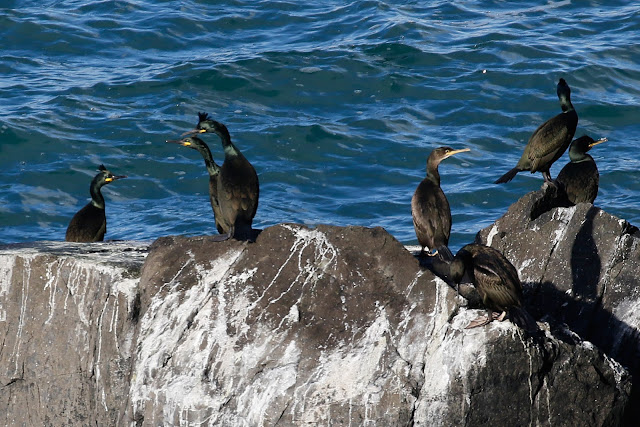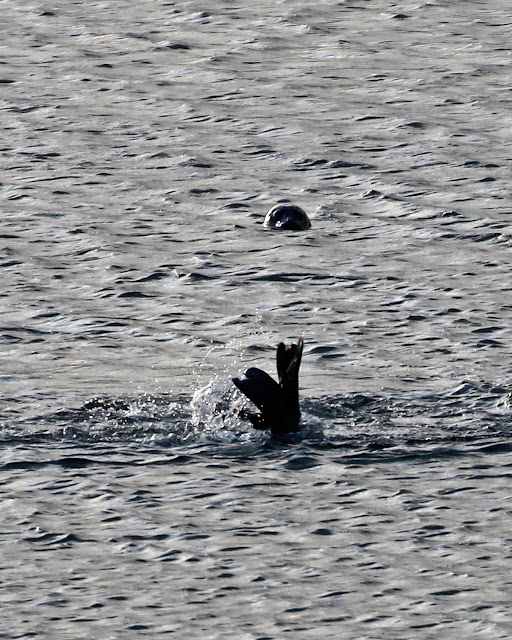It was clear, bright and cold first thing in the morning, so
cold and frosty that the pipes had frozen and there was no water! This
though did not distract from the scenery around us as the sun rose casting some
amazing light around the Shed.
And as the morning warmed up the views continued to change across the Loch and surrounding hills.
And as the morning warmed up the views continued to change across the Loch and surrounding hills.
There are two main views from the Shed, one looking out across the glen and loch, and the other looking up to MacLeod's Tables a pair of impressive flat-topped mountains, Healabhal Beag (1601
ft) and Healabhal Mor (1538 ft), that rise in gentle contrast to the jagged peaks of
the Black Cuillins.
This morning the view up to the mountain was framed by blue skies and a frosty ground.
Around the shed there were a pair of Song Thrush which was a bit of a surprise and several Hooded Crows, I always find it quite striking to see these crows with their smart grey waistcoats.
According to legend, the flat summits were created after the
visit of Saint Columba to the island. He was not well received by the Chief,
who at this time lived in a Dun on the shores of Loch Bracadale, and was
refused any hospitality.
St. Columba was invited to preach a sermon in the local
church and chose as his theme: "The rabbits have their warrens, the birds
have their nests but the messenger of the Lord has nowhere to lay his
head".
During the sermon, the skies blackened and the ground shook,
culminating in an almighty crash. On leaving the church, the congregation
discovered that the tops of the two local mountains had been struck off,
creating a bed for St. Columba to sleep on and a table for him to dine at.
This morning the view up to the mountain was framed by blue skies and a frosty ground.
Around the shed there were a pair of Song Thrush which was a bit of a surprise and several Hooded Crows, I always find it quite striking to see these crows with their smart grey waistcoats.
We were also welcomed by a small flock of Hebridean Sheep that
wandered around the grounds amongst the many rabbits. They looked to find the higher ground this morning to allow them get the the first rays of sunshine on the side of the hill.
After breakfast we decided to go for a walk from the Shed,
so set off down the track, flushing a single Common Snipe from the ditch by the
side of the lane.
We tried to get down to the beach, but found it difficult to
navigate across the open ground and rising tide with no real sign of any paths. Coming
back I flushed a Woodcock from close to the burn, that in places was frozen.
Back on the road we headed towards Glendale, stopping to
look over the Loch were there were Goldeneye and Red-breasted Mergansers
And a few dabbling ducks such as, Teal Mallard and Wigeon.
And a few dabbling ducks such as, Teal Mallard and Wigeon.
We walked as far as the Three Chimneys restaurant but away in the distance there was a rainbow over the hills, not a good sign.
Clouds were rolling in from the north so we decided to turn
back, and with a purposeful walk we managed to get back to the shed before a
squally shower came across from the Loch.
As we waited for the weather to improve we sat and drank coffee and watched the antics of the local rabbits.
We then decided to drive over to Neist Point, the most
westerly point of the island, and the site of a lighthouse and apparently some stunning views out across The Minch to the Western Isles
As we parked the gorgeous light was providing some wonderful views to the south of the
cliffs of Waterstein Head and all the way down towards Ramasaig.
To get to the lighthouse you follow a concrete path that
leads down and across a narrow piece of land with water on either side, and
wonderful views out towards the Western Islands. As the sun moved through the clouds the light and colour of the surrounding landscape continued to change.
And it wasn't just the land that was constantly changing colour, the sea too would take on different hues of green and blue.
And it wasn't just the land that was constantly changing colour, the sea too would take on different hues of green and blue.
The path took us down and then up and we could see birds on the water below. A
drake Eider was diving in the clear sea water.
Along with a summer plumaged Black Guillemot. The
water was so clear we could see them underwater as they dived, their red legs standing out so clearly.
Coming down the other side we were finally able to see the lighthouse.
Out to the north their were rafts of auks on the water, it was difficult to identify them clearly but they were probably returning Guillemots and Razorbills. I expected to see Fulmars around the cliff face, they usually start to return at this time of year, but the only birds cruising by were Great Black-backed and Herring Gulls. On the rocks below us were a group of Shags, the sun catching the bottle green plumage of the adult birds.
You could walk down to the waters edge, and climb across basalt rock which was weathered by the water. This stretch of rock leads south west out towards Staffa just off the Isle of Mull, and then across to the Giant's Causeway in Northern Ireland.
The rock is weathered by the sea and rain, and the areas of weakness show like joints,
Out to the north their were rafts of auks on the water, it was difficult to identify them clearly but they were probably returning Guillemots and Razorbills. I expected to see Fulmars around the cliff face, they usually start to return at this time of year, but the only birds cruising by were Great Black-backed and Herring Gulls. On the rocks below us were a group of Shags, the sun catching the bottle green plumage of the adult birds.
You could walk down to the waters edge, and climb across basalt rock which was weathered by the water. This stretch of rock leads south west out towards Staffa just off the Isle of Mull, and then across to the Giant's Causeway in Northern Ireland.
The rock is weathered by the sea and rain, and the areas of weakness show like joints,
We made our way back to the lighthouse, and back up the hill towards the car park. As we did we could see the weather was
closing in once again, with dark clouds away to the north contrasting against the sun lit cliffs.
Then as we left the car park it began snowing quite hard.
Then as we left the car park it began snowing quite hard.
From the point we drove back through the villages within the Glendale estate, past the Shed, and then around
to Dunvegan where we followed the road alongside the Loch. The road
then turned inland, and we came across the inland Loch Suardal where we found a herd of 10 Whooper
Swans.
Then just like every scene on this island the light changed and with it the background for the swans.
We often joke that a swan is not one of our favourite birds, but I always love to see the Whoopers and Bewick's Swans, birds that have travelled great distances to be here for the winter, and soon these swans will be making their way back to Iceland to breed.
As well as the swans there were several Wigeon, and Mallard.
We often joke that a swan is not one of our favourite birds, but I always love to see the Whoopers and Bewick's Swans, birds that have travelled great distances to be here for the winter, and soon these swans will be making their way back to Iceland to breed.
As well as the swans there were several Wigeon, and Mallard.
The road took us to a car park which was the base for a walk
to a series of Coral Beaches. We decided though to come back another
day, and then headed back towards Dunvegan. As the road passes close
to the water we stopped to watch Common Seals twisting and turning in the water.
There were two seals involved, and it was not clear what it was all about.
The loch is a good spot to see the seals there are many of them, and they can be see in the water, and hauled out on the rocks and beach. The two seals continued with their antics and it also attracted the attention of others too.
On the shore a Herring Gull had caught a starfish, but two hooded crows had seen it and while one edged closer as the gull watched it
The other other nipped in and took the starfish when the gull dropped it which was much to the annoyance of the gull.
The loch is a good spot to see the seals there are many of them, and they can be see in the water, and hauled out on the rocks and beach. The two seals continued with their antics and it also attracted the attention of others too.
On the shore a Herring Gull had caught a starfish, but two hooded crows had seen it and while one edged closer as the gull watched it
The other other nipped in and took the starfish when the gull dropped it which was much to the annoyance of the gull.
Despite a chase and fight the Gull eventually gave up on the starfish, and the two crows shared their prize.
We stopped in Dunvegan to look out over the tidal mud where
Hooded Crows and Gulls were feeding along with a single Curlew.
Out across the point the sun was sending a shard of light through the clouds that were disappointingly gathering, at one point the light seemed to pick out the top of the cliffs.
The problem with watching the sky to the west was that you missed what was going on behind us, and just like before the clouds and rain rolled in over the hills and completely changed the views in an instance.
But it seems if you don't like the weather here you just need to wait a short while and something you do like will come along. In this case it wasn't the perfect sunset over the Western Isles but it was quite acceptable.
The cloud was going to spoil the final moments so we decided to turn back and head off to the Shed, the lure of the log burner huge on a cold afternoon.






































No comments:
Post a Comment